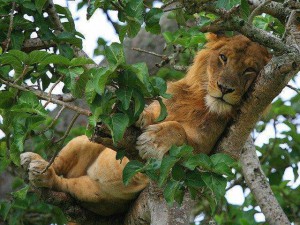
Uganda has ten gazetted National Parks covering an area of 11,273km2, spanning mainly the eastern and western international borders of the country (Map 1). Together with the areas covered by forests and 12 existing wildlife reserves, these occupy 21 % of the total surface area of the country (SOE, 2001). Three of these National parks, Murchison Falls (Murchison falls national park), Queen Elizabeth (Queen Elizabeth national park) and Kidepo Valley (Kidepo Valley national park) National Park, which occupy 7,407km2 (65.7%) of the total national parks area, are the major range areas, where a reasonable population of lions reside.
Being a small country (194,000km2 land area), with a high population density of 113/km2 and a high population growth rate of 2.5%, the population estimate for 2005 was 25.0 million (SOE, 2001), and 84% of these live in rural areas practicing pastoralism and subsistence agriculture. The negative effect of this has spilled over to the protected areas in that increased demand for food for the additional people means new land areas must be opened for agriculture, thus tremendous pressure has been put on the biodiversity resources. Human settlements have encroached onto the protected areas resulting into some of the areas being excised off because of extensive settlement (EPED, 1999 and UWA, 1999). Most of the wildlife corridors and previously existing buffer zones have either been constricted or resettled altogether, resulting into island meta-populations of wildlife existing in the protected areas, meaning that there is vast loss of genetic biodiversity, especially in species whose populations are small and need reinforcement through migrations and cross interactions. Wildlife on the other hand are forced to invade settled areas with a potential for cross breeding, disease transmission, persecution and other human-wildlife conflicts then become enhanced.
On the same note, substantial decline, extermination and compression of large carnivore populations as well as decline in both numbers and distributions of their populations have resulted in Uganda, especially during the time of lawlessness in the country between 1970s and early 1980s. Local extinctions have occurred to some lion populations in Ugandan, like Lake Mburo National Park (LMNP), while in others like the Semulikis, the numbers have reached very low levels of less than 10.
Status qua of the lion population in Uganda
Unlike for periodic big game population censuses since the 1960s, there has been no such data for lions because of the difficulties involved in their population surveys, thus monitoring of their population trends has never existed in the past. However, in 1997, Lion Project was conceived in Uganda because of deaths of lions reported in Queen Elizabeth national park and to address the uncertainties surrounding the population status that time.
Methods
Population surveys were conducted using total counts and audio calls following Ogutu and Dublin (1987) and Sutherland, (1996) in selected areas of Queen Elizabeth national park from 1997-1999 (Driciru, 1999), in Murchison falls national park from 2000 to 2002 (Driciru, 2003), and in Kidepo Valley national park from 2002 to 2004. Monitoring of the known groups of lions was done in Queen Elizabeth national park from 2001 to 2004 (Siefert, 2003), and in Murchison falls national park from 2003 to 2004 (Okecha, 2004). Individual lions were identified following the methods of Pennyquick and Rudnai (1970), and Schaller, (1972), and identification cards and photo albums were made for coded individuals. Georeferenced locations were plotted on maps using ArcView GIS program for spatial distribution. Selected lions were darted with combinations of safe anesthetic drugs, blood samples collected from them aseptically and analyzed in reference laboratories for sero-prevalence to various feline viral diseases. Attitude surveys were conducted through participatory questionnaire methods amongst the local communities, in which information was gathered on existing predator-community conflicts, attitudes of people towards predators and possible conflict resolution strategies.
Findings
Maps 2 through 5 show the distribution of lions in the parks between 1998 and 2002. Table 1 shows the numbers of lions found in the described areas during the periods mentioned. It indicates that the lions, which are known by lion project in selected areas of Queen Elizabeth national park, Murchison falls national park and Kidepo Valley national park between 1997 and 2004, are 214. Projections derived from population densities found in the areas covered by the project gives a figure varying from 354 to 745 lions in the park. Although it is difficult to determine population trends over the years because of lack of scientific information, comparing the patches of information, Table 1 indicates that in Queen Elizabeth in the 1970s, the population of lions was much higher than it is now. However, comparing studies done by Din, 1978, van Orsdol, 1981 and Driciru, 1999, in the Ishasha sector in Queen Elizabeth national park the lion population has remained more or less stable, but populations in the northern sector of Queen Elizabeth national park have declined. In Lake Mburo National Park, the lions have gone extinct, and this has been attributed to their extirpation by the livestock keeping communities because of lionlivestock predation. In Queen Elizabeth national park, between 1999 and 2002, a total of 16 – 30 lions have been lost (9 females and 4-5 males), giving an annual rate of 2.25 per annum for females and 1-1.5 per annum for males. Meanwhile, in Murchison falls national park, the losses have been found to be similar, between 1994 and 2002, and at least the management shot 3 of these lions because of man-eating habits. Male cub sex bias has been observed in the Murchison falls national park population between 2000 and 2004 (5 consecutive years), with at least 66.7% of the registered cubs being male.
Interested in big cat safaris, click here for a list of packaged safaris featuring lions and other big cat safaris in Uganda.

 Posted in
Posted in 

